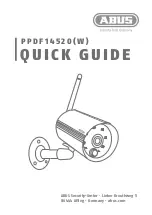
AVT GigE Cameras Installation Manual V1.1.0
39
Using multiple cameras
Single Ethernet port
Multiple cameras are connected to a switch. The switch is connected to a single
Ethernet port. This is the simplest multiple camera installation. The cameras
can be managed using Auto IP, no additional configuration on the switch is nec-
essary.
This architecture combines bandwidth coming from each camera onto a single
cable connected to the host. To prevent packet collision, resulting in dropped
packets, the user is required the reduce
StreamBytesPerSecond
feature on each
camera, such that the sum doesn’t exceed 125,000,000 Bps.
Example:
Camera 1
: GE1900, full resolution, Mono8 pixel format, at 15 fps
Bandwidth usage = 1920 x 1080 x 1 x 15 = 31,104,000 Bps
Set
StreamBytesPerSecond
= 31,104,000 Bps.
Camera 2
: GE1650C, full resolution, Bayer GB8 / Bayer 8 pixel format, at 5 fps
Bandwidth usage = 1600 x 1200 x 1 x 5 = 9,600,000 Bps
Set
StreamBytesPerSecond
= 9,600,000 Bps.
Camera 3
: GC2450, full resolution, Mono8 pixel format, at 5 fps
Bandwidth usage = 2448 x 2050 x 1 x 5 = 25,092,000 Bps
Set
StreamBytesPerSecond
= 25,092,000 Bps.
Total bandwidth consumed = 31,104,000 + 9,600,000 + 25,092,000 =
65,796,000 Bps
www
For more information on
StreamBytesPerSecond
and camera
pixel format, see:
PvAPI users
:
GigE Camera and Driver Attributes
document
VIMBA users
:
GigE Features Reference
document
Figure 26: Multi-camera network configuration using a switch and single Ethernet port
















































